Windsor Castle: Inside the 1,000-Year-Old History of the Royal Residence

- Oops!Something went wrong.Please try again later.
- Oops!Something went wrong.Please try again later.
- Oops!Something went wrong.Please try again later.
Photo: Noam Galai/GC Images/Getty Images
For nearly a thousand years, Windsor Castle has stood as a symbol of Britain’s strength and power. As the oldest and largest occupied castle in the world, Windsor holds endless history within its walls. The 484,000-square-foot castle features over 1,000 rooms, more than 300 fireplaces, and a substantial royal collection of paintings, armor, and furniture to rival any museum.
The castle boasts numerous design and architectural styles thanks to the 39 kings and queens of the United Kingdom who have called the palace home. From Norman to Baroque to Gothic, each room is grander than the next. Read on as we share the rich history of Windsor Castle and all the information you need to know before you visit the stately residence yourself.
The origins and construction of Windsor
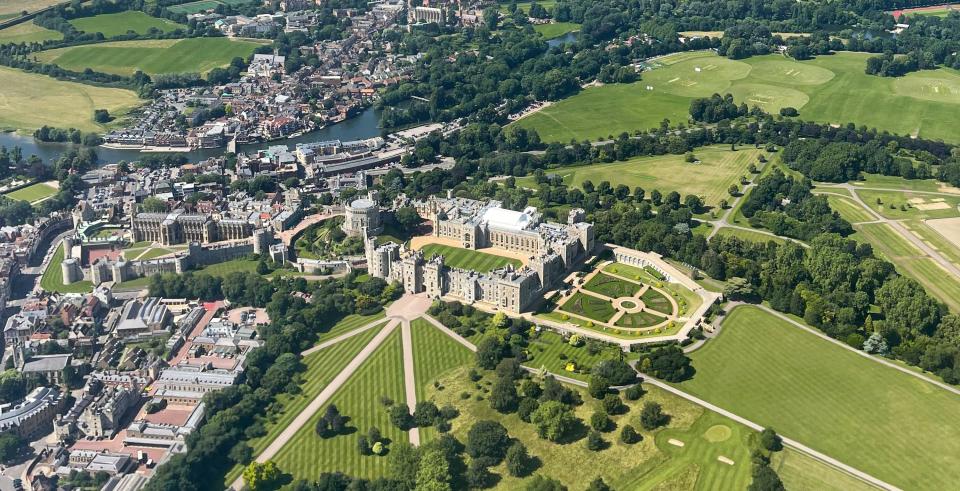
Windsor Castle - Aerial
Windsor is the oldest and largest inhabited castle in the world, according to the official Windsor Castle guidebook provided to AD by the Royal Collection Trust. The royal residence has remained in almost continuous use since around 1070, when it was built by William I (also known as William the Conqueror) after winning the Battle of Hastings. The castle was originally built high above the River Thames to guard London from the western approach.
Being that William I was the first Norman king of England, “Windsor followed the typical Norman design of a motte-and-bailey castle. This comprises a central round tower (or keep) constructed on an artificial earthen mound (motte), set within a walled courtyard (bailey),” Dr. Richard Williams, Learning Curator at Royal Collection Trust, tells AD. “The original keep would have been constructed of timber, but this was rebuilt in stone around 1225.” If you’re curious to see what Windsor looked like at the time of its origin, you’re in luck. “Decorative stone fragments from the 12th-century royal apartments of the castle are currently on display for visitors in the lapidarium,” says Williams.
The royal residence went on to see endless expansions and transformations. The first order of business was converting the castle—built for defense purposes—into an elegant residence occupied by royalty, heads of state, or heads of a church and designed for comfort and elegance. This major transformation was spearheaded by Henry II, when he had two sets of royal apartments built within the walls of Windsor: an official state residence in the lower ward and a smaller private residence of his own in the upper ward. Henry III later added a large new chapel and further improved the private apartments in the upper ward.
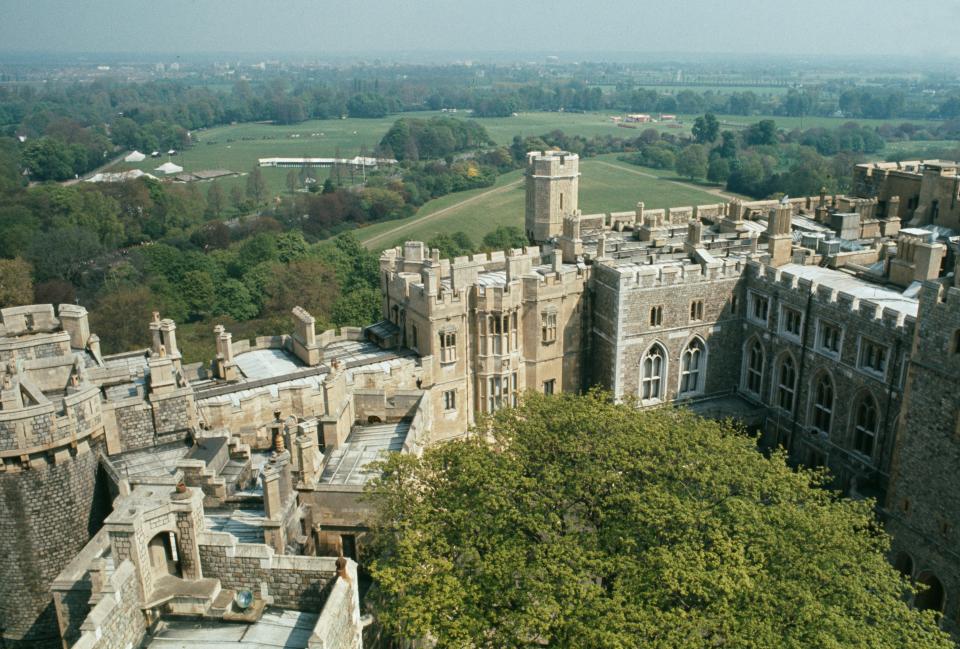
Windsor Castle, Berkshire
Throughout much of the second half of his reign (from the 1350s to 1377), Edward III made it his mission to take Windsor from a military fortification and turn it into a Gothic palace. He is said to have spent 50,000 British pounds, which is more than any other medieval English king spent on a single building.

The Funeral Of Prince Philip, Duke Of Edinburgh Is Held In Windsor
Edward IV, who seized power in 1461, is whom we have to thank for St George’s Chapel, according to the official website of the royal family. “St George’s Chapel is one of the finest examples of Gothic architecture in Europe,” Williams tells AD. It has since become customary for royal funerals and burials to take place here. You can visit the final resting places of Edward IV, Henry VI, Henry VIII and Jane Seymour, Charles I, Edward VII and Queen Alexandra, and George V and Queen Mary, according to Britannica.
In the late 1400s, Henry VII built a three-story tower on the west end of the palace, which became his personal living quarters. His successor, Henry VIII, is most known for his addition of a gateway at the bottom of the lower ward and a wooden terrace along the north side of the upper ward.
Elizabeth I moved to Windsor at a time when the castle was in desperate need of restoration. This led to an extensive program of improvements throughout the 1570s, which included a long gallery overlooking the North Terrace.
Charles II updated the royal apartments around the 1670s or 1680s, transforming them into the grandest Baroque state apartments in England at the time.
It was George III who brought neoclassical design into the mix. He can be credited with the additions of a music room and a new dining room, as well as reimagining the exterior of the castle into a Gothic palace.
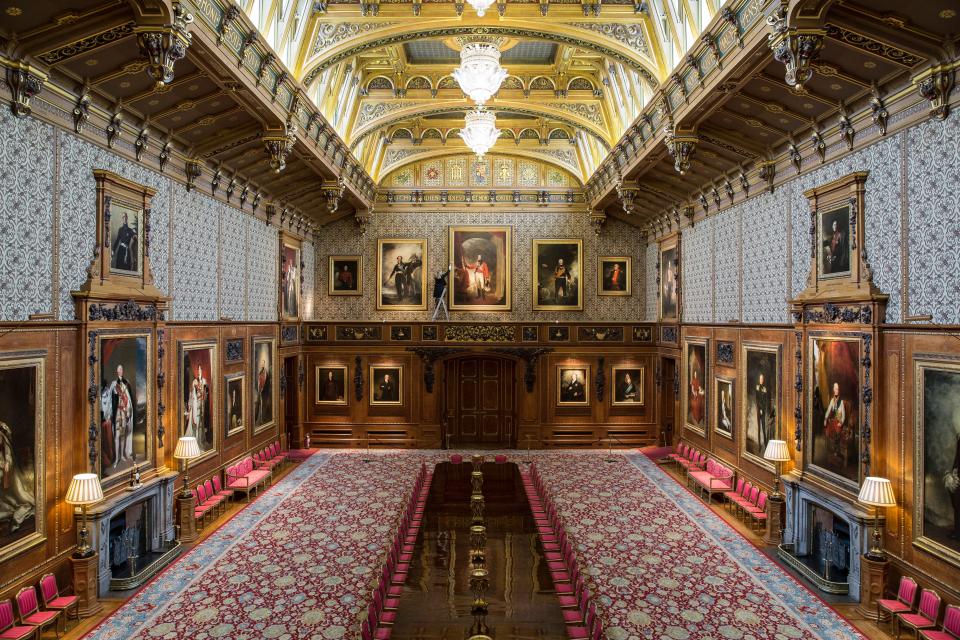
Press preview for Waterloo at Windsor: 1815-2015 Exhibition
After his succession to the throne in 1820, George IV carried on with the Gothic transformation of the castle started by his father. He and his artistic advisor, Sir Charles Long, “wanted the exterior of the castle to have a more imposing appearance,” states the Royal Collection Trust website. The list of improvements that George IV made to Windsor are endless, from refashioning the exterior in Gothic crenellations, turrets, and towers, to installing a new grand staircase and the Waterloo Chamber. He also employed the help of the firm Morel and Seddon to supply French Empire-style furnishings. By the time the king finally took up residence at Windsor towards the end of 1828, his improvements to the castle had cost nearly 300,000 British pounds, according to the Royal Collection Trust.
Queen Victoria, who reigned for 63 years, had little to restore thanks to George IV’s expansive renovation of Windsor. Her main addition to the palace was the creation of a new private chapel at the eastern end of St George’s Hall, as well as the reconstruction of the grand staircase and the completion of the royal mews and riding school in the 1840s.
Queen Victoria’s successor, King Edward VII, was a bit more of a minimalist than his ancestors, and he was not so fond of the “somber and cluttered” interiors the castle had acquired throughout his mother’s reign. He took creative liberties by simplifying and rearranging the contents of numerous rooms. He also re-hung the principal state apartments with silk damask.
King George V created new guest suites on the south side of the castle in the early 1900s.
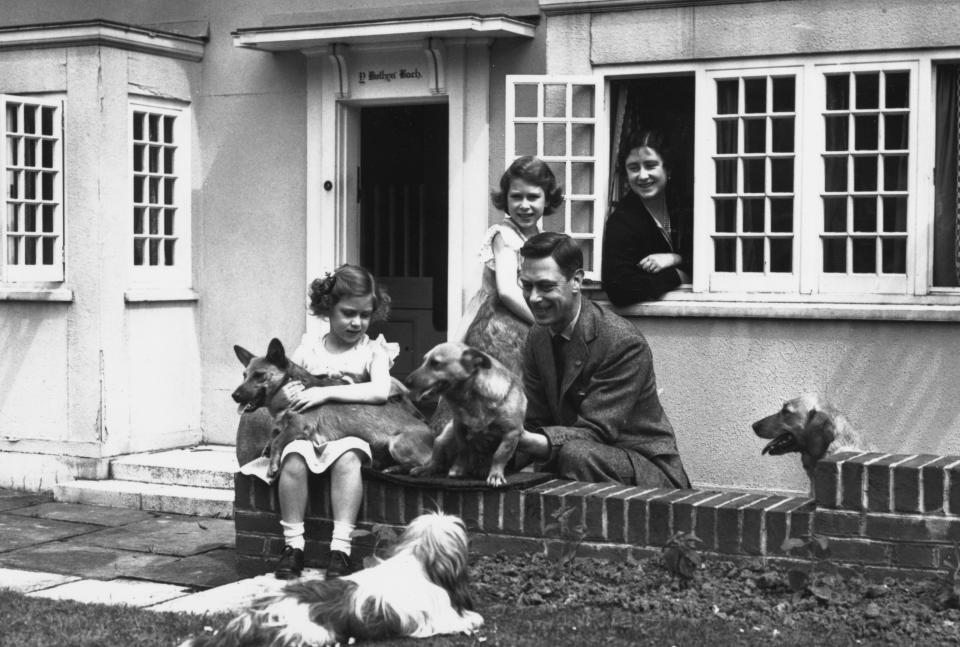
Royal Welsh House
It was from this point on that the royal family as we know it today claimed Windsor as their own. King George VI and his family—most importantly his daughter, the future Queen Elizabeth II—split their time between Windsor and Buckingham Palace.
The fire at Windsor
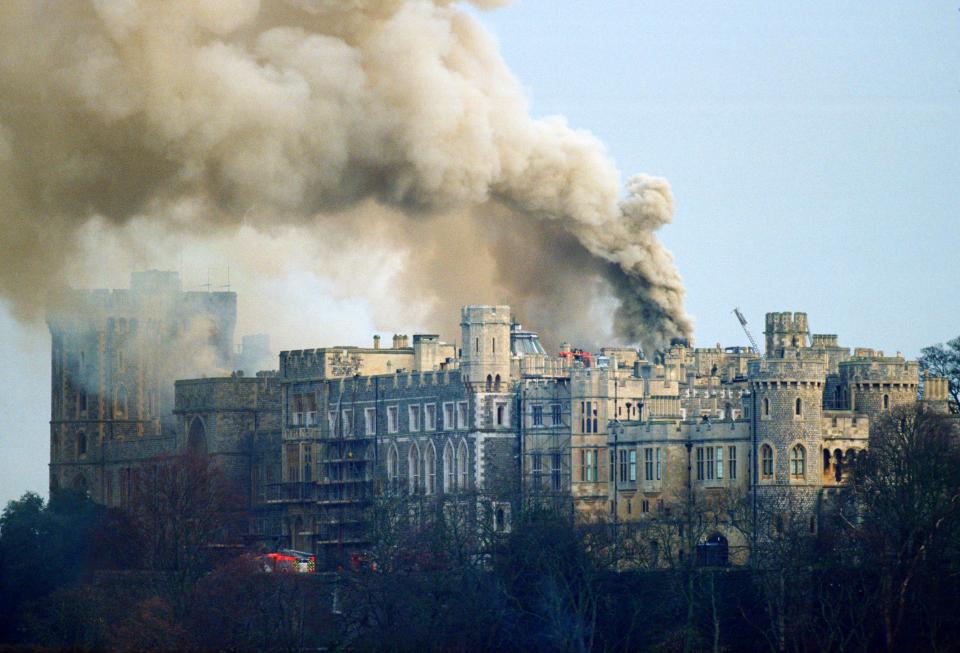
Fire At Windsor Castle
On November 20, 1992, a devastating fire wreaked havoc on Windsor Castle, nearly destroying years and years of history. The fire started shortly before noon in Queen Victoria’s private chapel, when a faulty spotlight ignited a curtain next to the altar. Within mere minutes, the flames had engulfed St George’s Hall—a medieval banquet hall—and became virtually unstoppable.
“One of the worst things was coming up the motorway, coming here and seeing this glow and the smoke pouring into the sky,” then Prince Charles said in the documentary Windsor Castle: After the Fire. “It looked even more a scene of utter devastation than I would have believed possible. It made the blood run cold.”
The fire was a dark moment in Windsor history that affected more than just the royal family. “I was very young, but I remember seeing the smoke and glow of the fire, making the silhouette of the castle stand out against the skyline,” Alfie Boyle, a former resident of Windsor on and off for 27 years, tells AD. “I had been visiting my grandparents in west London and we were driving back over the elevated freeway, which gave you an unobstructed view of the castle.”
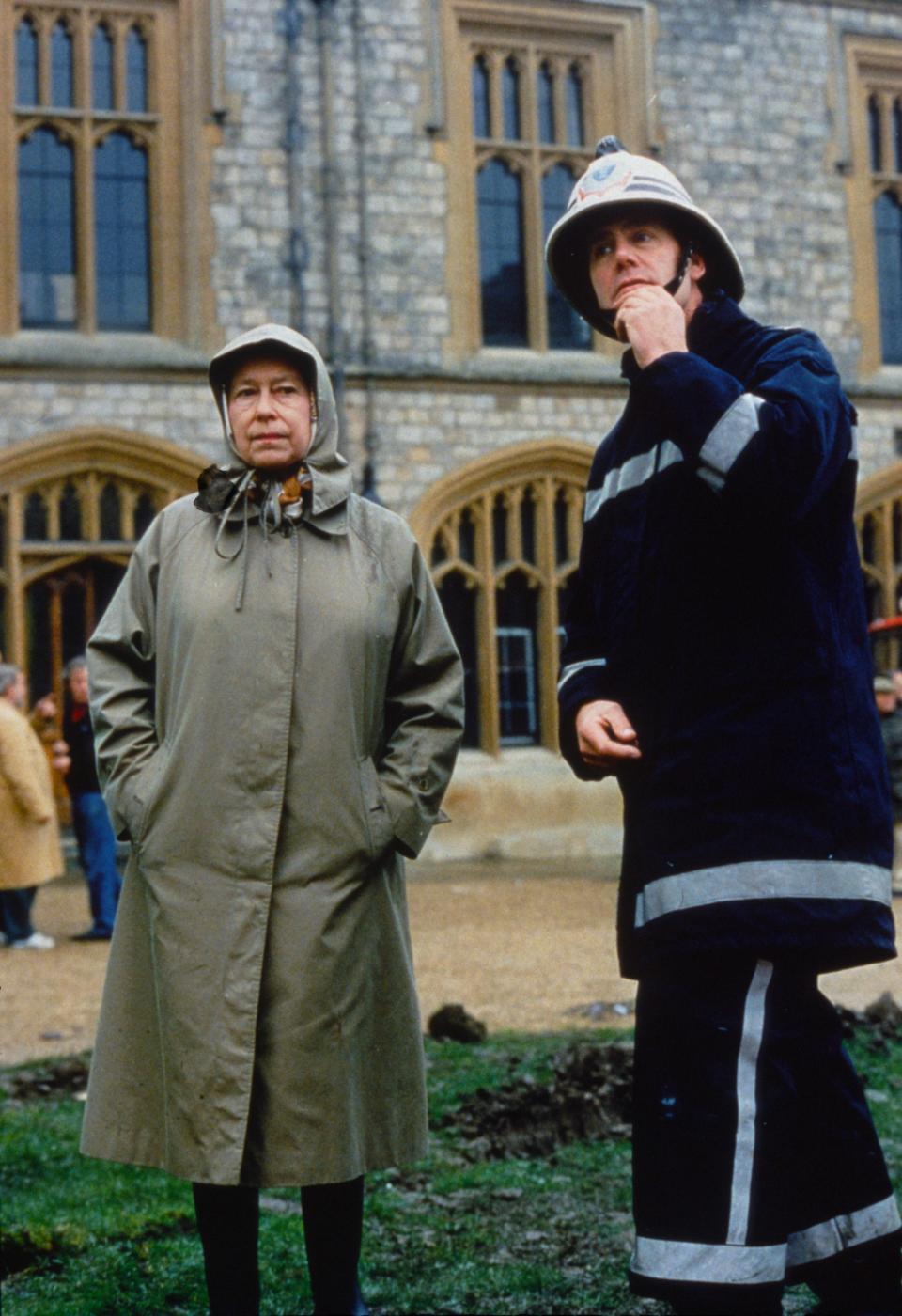
Queen Windsor Fire
Windsor staff became heroes that day, removing precious works of art from the royal collection and saving them from the path of the fire. The castle’s Quadrangle was home to some of the finest pieces at Windsor, such as 18th-century French furniture and paintings by Anthony Van Dyck and Peter Paul Rubens. In the end, only two precious words of art were lost in the blaze: a rosewood sideboard and a large painting by Sir William Beechey.
It took 15 hours and 225 firefighters to battle the flames, using one-and-a-half million gallons of water, according to the documentary. The fire damaged 115 rooms, most notably the Grand Reception Room, which is perhaps the most striking room in all of Windsor Castle.
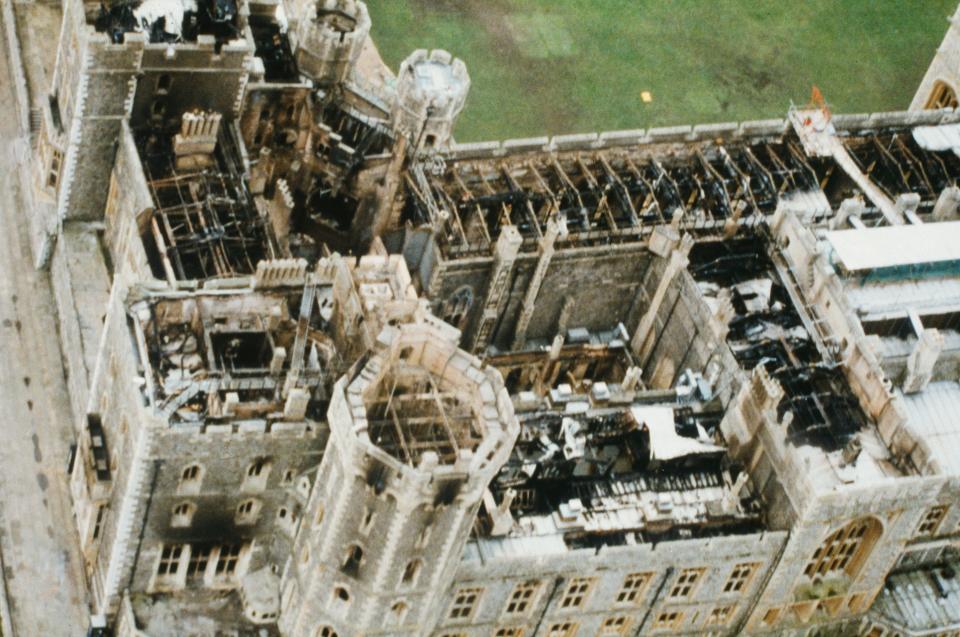
Windsor Castle after the fire
The restoration committee, chaired by Prince Philip (then Duke of Edinburgh) swiftly began rehabilitating the castle to its former glory. The restoration of the destroyed rooms was completed on November 20, 1997—exactly five years later. The celebration coincided with the 50th wedding anniversary of Queen Elizabeth II and Prince Philip. “It resulted in the greatest historic building project to have been undertaken in this country in the 20th century, reviving many traditional crafts,” states the official website of the royal family. The restoration cost roughly £37 million, which still was around three million British pounds below budget.
Queen Mary’s dollhouse
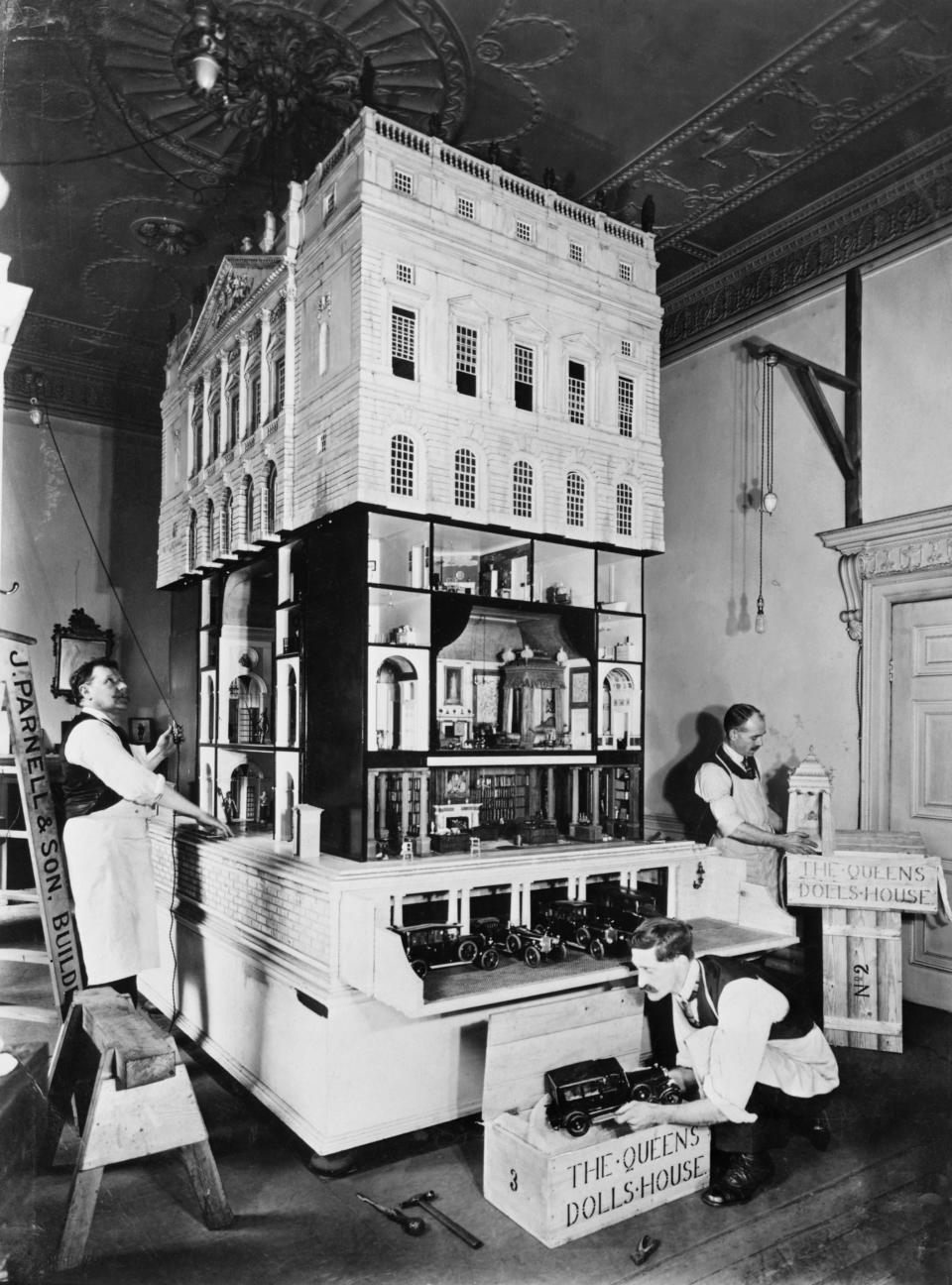
Queen Mary's Doll House, Presented To Her In 1923 As A Token Of National Goodwill
Windsor is home to some objects of great historic interest, “such as the bullet that killed Admiral Lord Nelson at the Battle of Trafalgar,” Williams tells AD. But one of the most fawned-over treasures in the castle is Queen Mary’s dollhouse, which was created as a 1:12 scale miniature royal palace. It was built between 1921 and 1924 as a gift from the nation to Queen Mary. “The idea behind the model was that it would be as true to life as possible, recreating every facet of modern-day life from the 1920s. According to the Royal Collection Trust, “it contains around 1,000 miniature works of art.”
The idea for the house came from the mind of Princess Marie Louise, a cousin of King George V and a childhood friend of Queen Mary. It is said that the queen loved all things diminutive and decorative. Marie Louise recruited the help of English architect Sir Edwin Landseer Lutyens. Together they created a committee that worked to decide on the style of the house and ensured that all of its contents were of the highest possible quality.
The finished dollhouse was more than just something to admire—it was a real functioning home, albeit very petite in size. It had running water, electric, working elevators, real food and soap, a complete set of miniature crown jewels, and a working bicycle. The committee went as far as properly upholstering the chairs, dovetailing the joints in the furniture, and embroidering the sheets with the royal cipher.
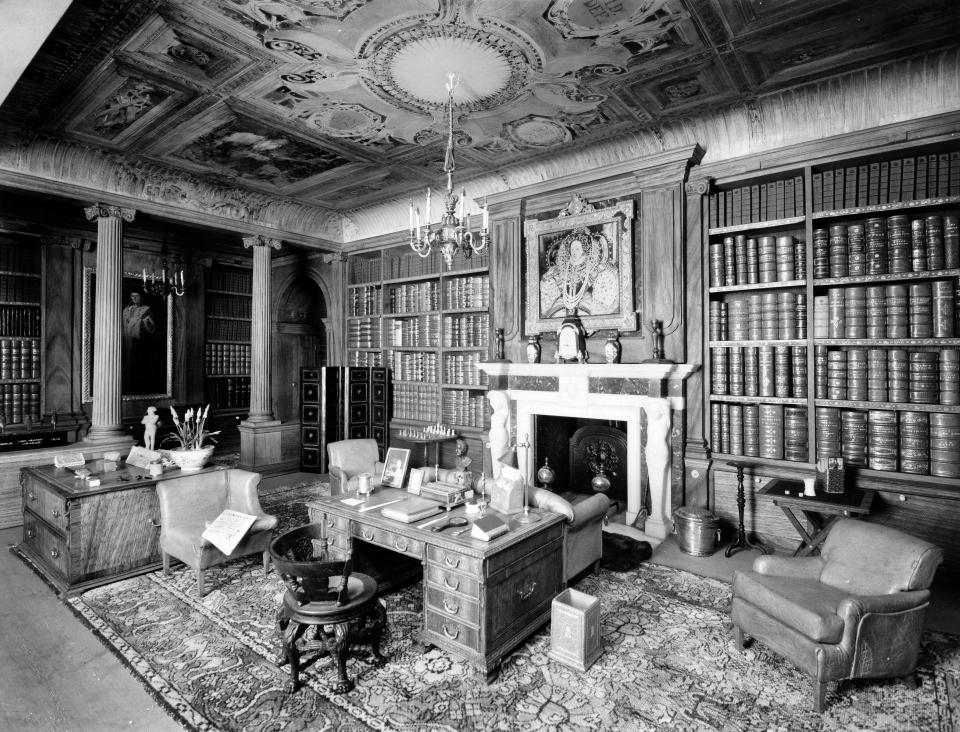
The dollhouse of Queen Mary II of England. The library. - Photographer: Topical Press Agency- Published by: 'Der heitere Fridolin' 21/1924Vintage property of ullstein bild
“I remember being in awe of it as a child,” Boyle tells AD. “What sticks in my mind is the detail. The full electronics, the lighting, table lamps, ceiling lamps and all. The fully stocked kitchen with its mise en place setups.”
The team spared no expense when it came to outfitting the dollhouse’s mini library. It is said that Princess Marie Louise and Lutyens approached many of the leading artists, composers, and writers of the day to contribute. The result? 588 miniature books, from Shakespeare to the Bible, to novels and poems. The shelves also contain over 700 watercolors, prints, and etchings, as well as 24 miniaturized music scores. If you can’t make a trip to visit for yourself, a virtual tour can be found here.
Windsor today
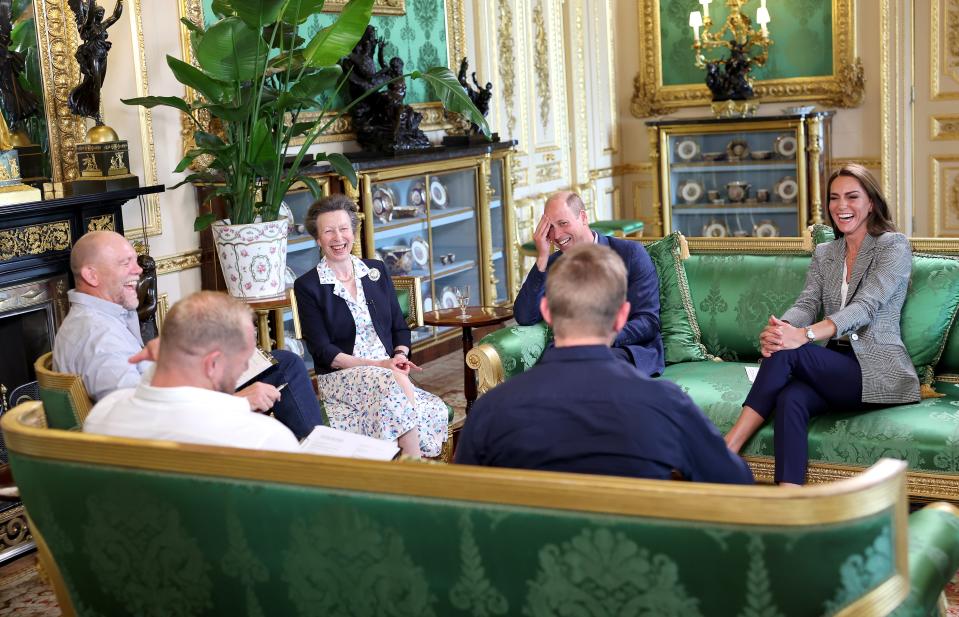
Special Episode of The Good, The Bad and The Rugby Podcast Recorded at Windsor Castle
Queen Elizabeth II grew up as a young princess at the Royal Lodge in Windsor Great Park, and by the time she became queen in 1952, Windsor Castle already felt like home. It was at Windsor that the queen and her sister, Princess Margaret, spent their childhood safely away from London and the Blitz during 1940 and 1941.
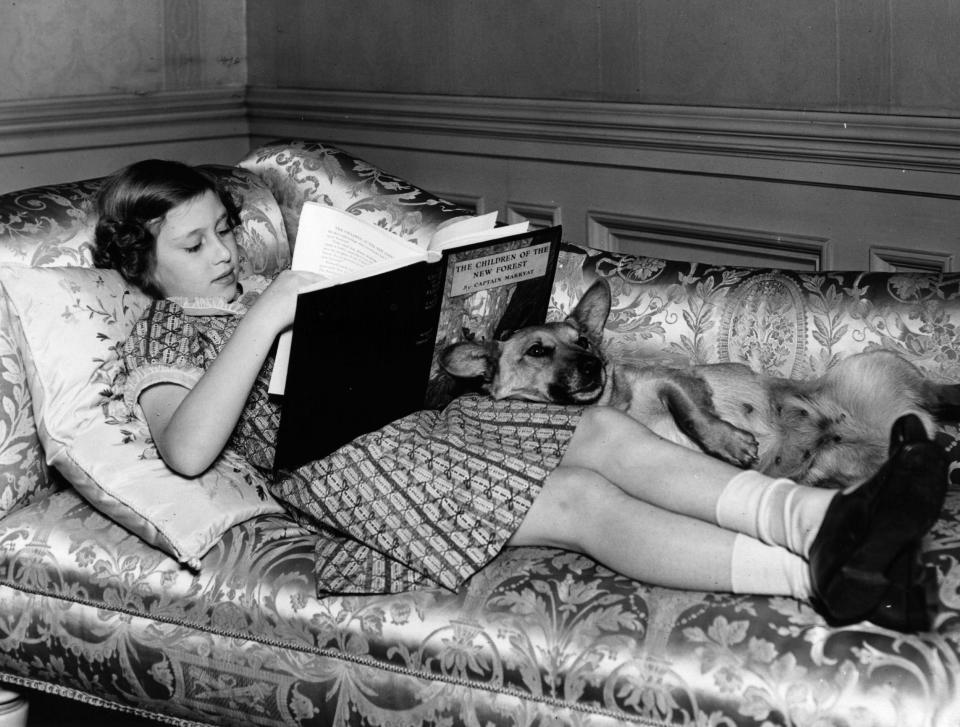
Reading On Sofa
Throughout her 70-year reign, the queen found comfort in Windsor and spent weekends at the castle. And she wasn’t alone: Prince Harry and Meghan Markle briefly occupied Frogmore Cottage on the grounds of Windsor, moving in just before the birth of their son, Archie, in 2019. Three years later, Prince William and Kate Middleton (then Duke and Duchess of Cambridge), along with their three children, Prince George, Princess Charlotte, and Prince Louis, relocated from Kensington Palace to Adelaide Cottage in Windsor Home Park. The 655-acre estate is part of the private grounds of Windsor Castle, providing the royal family with space and freedom away from busy London.
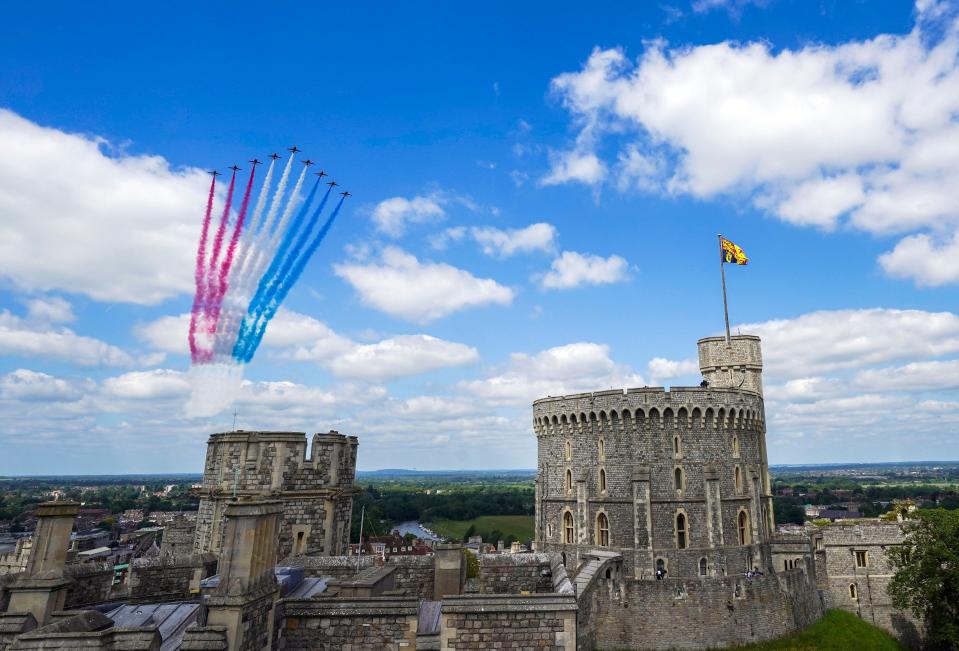
Trooping Of The Colour 2021
During Queen Elizabeth’s final years, she spent a lot of her time at Windsor Castle, partly due to the pandemic. It is at the castle where the late Prince Philip died and was buried in 2021, just over a year before the queen’s passing in 2022. The couple was interred together at the King George VI Memorial Chapel, an annex to St George’s Chapel.
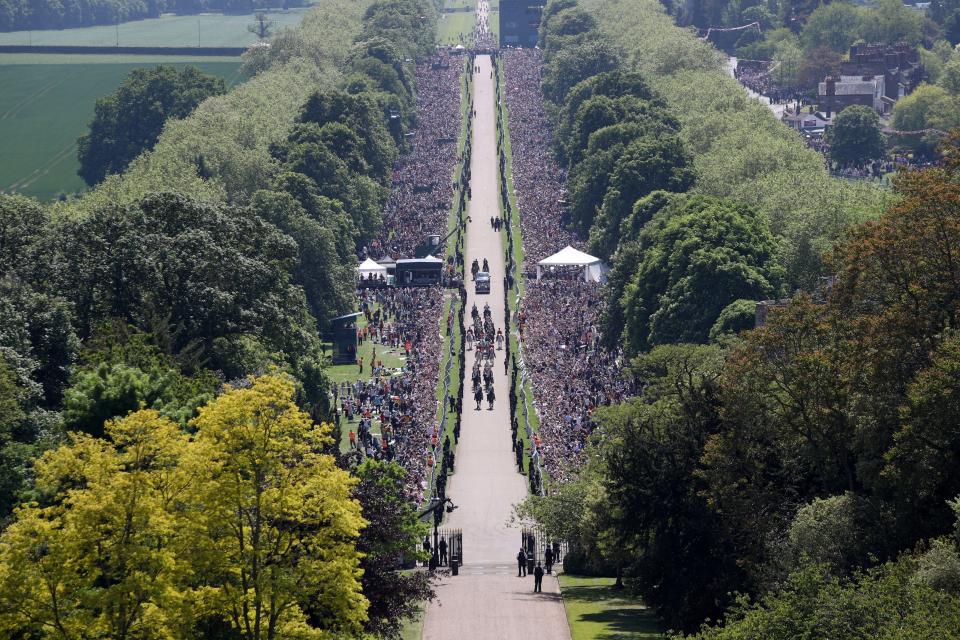
Prince Harry Marries Ms. Meghan Markle - Procession
In addition to state funerals, Windsor Castle has also been home to royal weddings. Prince Harry and Meghan Markle were married there on May 19, 2018, attracting up to 423,000 well-wishers to Windsor (according to estimations made by a lecturer-and-student team at the Manchester Metropolitan University). Among those in attendance were Oprah Winfrey, Elton John, and Serena Williams. Those who tuned in via live television remember the scenes of royalists cheering as the future Duchess of Sussex made her way along the Long Walk in a Rolls-Royce Phantom IV motorcar.
Windsor Castle holds endless bounds of modern and ancient history. If you’re looking to plan a visit for yourself, keep reading. Our FAQ is here to make your experience as seamless as possible.
FAQs
Who lives at Windsor Castle now?
King Charles III, who inherited Windsor Castle when Queen Elizabeth II died, splits his time between Clarence House, Windsor, Balmoral, and his other estates.
In addition to the royal family, Windsor has plenty of other occupants. According to the official website of the royal family, those who live at Windsor include: the titular head of the castle community, the constable and governor of Windsor Castle, and the dean of Windsor. You’ll also find the military knights of Windsor, the superintendent of Windsor Castle and his staff, the housekeeper and her staff, and soldiers who mount a permanent military guard in the castle.
Which is bigger, Buckingham Palace or Windsor Castle?
Buckingham Palace is over 828,000-square-feet large, making it larger than Windsor Castle.
How far apart are Buckingham Palace and Windsor Castle?
Windsor Castle is a little over 20 miles away from Buckingham Palace. It’s about a 40-minute drive or a one-hour train ride.
Which is older? Windsor Castle or Buckingham Palace?
Construction of Windsor Castle began in 1070, making it more than 600 years older than Buckingham Palace, which opened its doors as Buckingham House in the early 18th century.
Where is Windsor Castle?
Windsor Castle is located in its namesake town of Windsor, England. It’s in the Royal County of Berkshire, just south of the River Thames. Across the river you’ll find Eton and the famous Eton College, a boys boarding school founded by King Henry VI in 1440. Both Prince William and Prince Harry are alumni.
What time is the changing of the guard?
Guard change at Windsor Castle takes place at 11 a.m. on certain days of the week.
Can you visit the state apartments at Windsor Castle?
The state apartments are open when the castle is open, with a few exceptions throughout the year when official state events are taking place, according to the Royal Collection Trust. “The state rooms are those where the sovereign carries out official duties. They are used today for ceremonies such as investitures or formal banquets”, Williams tells AD.
Can you visit Windsor Castle?
The castle is open to visitors Thursday to Monday. Standard admission ranges from 15 to 30 British pounds. You can also take private guided tours of Windsor Castle and behind-the-ropes tours of Queen Mary’s dollhouse.
What are the visiting hours for Windsor Castle?
Closing and opening times may vary. From March 1 to October 31, the castle is open 10 a.m. to 5:15 p.m. From February 29 to November 1, the castle is open from 10 a.m. to 4:15 p.m. Keep in mind that Windsor is a working royal palace, so there may be closures to the entire castle or the state apartments at any time. “At times, when the king is in residence, the castle remains open to the public. Visitors know this is the case from the flag flying on top of the Round Tower. When the king is at the castle, the royal standard flies, but when he is not, the Union Flag takes its place,” Williams tells AD.
How can I book tickets to tour Windsor Castle?
Booking tickets to the castle is as easy as visiting the Royal Collection Trust’s website. It is recommended you book in advance for the best value and to guarantee entry.
Originally Appeared on Architectural Digest
More Great Celebrity Style Stories From AD
Inside Benny Blanco’s Eclectic LA Home, Which Doubles as Hollywood’s Favorite Hangout
Windsor Castle: Inside the 1,000-Year-Old History of the Royal Residence
20 Years After Mean Girls, Regina George’s Bedroom Still Reigns Supreme
Inside Bad Bunny’s Houses: Tour Where the Latin Superstar Lives
Not a subscriber? Join AD for print and digital access now.
Browse the AD PRO Directory to find an AD-approved design expert for your next project.

